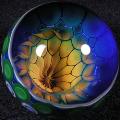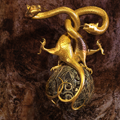
Nice guy
Posts: 95 Joined: 10-May-2008 Last visit: 06-Jun-2012 Location: Loowlaands
|
If any of the knowledgeable people here can help me out, I would be most grateful. Considering a mixture of DMT, DMT-n-oxide, 5-HO-DMT and 5-MeO-DMT, what would the chemist use to separate these? The little information available suggests using silica as stationary phase. Could Alumina be used and, if so, what activity grade should it be converted to? My ideal view of the procedure is to bring the mixture dissolved in solvent A on the column, then elute the components using different solvents (B, C, D) or gradients of them. What would these solvents and/or gradients be? Obviously, DCM could be a logical choice for solvent A and heptane could be used to separate DMT from its oxide, but what about the others? I hope someone can shed a light on this. benzyme wrote:you're preparing drugs, not salad.
|
|
|
|
|

analytical chemist
   
Posts: 7463 Joined: 21-May-2008 Last visit: 09-Aug-2025 Location: the lab
|
for some dmt synths, a binary solvent mixture of EtOAc:MeOH is eluted through silica, and the product is recrystallized with boiling hexane (of course heptane would also work) "Nothing is true, everything is permitted." ~ hassan i sabbah
"Experiments are the only means of attaining knowledge at our disposal. The rest is poetry, imagination." -Max Planck
|
|
|

DMT-Nexus member
Posts: 5826 Joined: 09-Jun-2008 Last visit: 08-Sep-2010 Location: USA
|
There are a lot of solvents that will work. An important bit of information to consider is the polarity of the compounds you will be separating. If using silica, the most polar will elute last. If using alumina, the opposite is true. The polarity is in this order: DMT < 5-MeO-DMT < DMT-n-oxide < 5-HO-DMT Using silica, ethyl acetate will elute DMT followed by 5-MeO-DMT followed by DMT n-Oxide, but 5-HO-DMT will not easily elute with ethyl acetate. 5-HO-DMT will easily elute with a 50:50 mix of ethyl acetate and methanol. SWIM once used dry flash chromatography to separate the 5-HO-DMT from the toxins in Yopo. The toxins would not elute with a 50:50 mix of ethyl acetate and methanol because they are too polar. The toxins where nearly impossible to elute with any solvent. They stayed suck in the silica. So with that said, ethyl acetate is polar enough to elute everything down to DMT n-oxide. So to separate DMT, 5-MeO-DMT, and DMT-n-oxide, you’ll need something less polar than ethyl acetate. You may remember me as 69Ron. I was suspended years ago for selling bunk products under false pretenses. I try to sneak back from time to time under different names, but unfortunately, the moderators of the DMT-Nexus are infinitely smarter than I am.
If you see me at the waterpark, please say hello. I'll be the delusional 50 something in the American flag Speedo, oiling up his monster guns while responding to imaginary requests for selfies from invisible teenage girls.
|
|
|

Nice guy
Posts: 95 Joined: 10-May-2008 Last visit: 06-Jun-2012 Location: Loowlaands
|
Wow, the knowledgeable ones indeed! Thanks guys! 69ron wrote:An important bit of information to consider is the polarity of the compounds you will be separating. If using silica, the most polar will elute last. If using alumina, the opposite is true.
The polarity is in this order:
DMT < 5-MeO-DMT < DMT-n-oxide < 5-HO-DMT
Using silica, ethyl acetate will elute DMT followed by 5-MeO-DMT followed by DMT n-Oxide, but 5-HO-DMT will not easily elute with ethyl acetate. 5-HO-DMT will easily elute with a 50:50 mix of ethyl acetate and methanol. That sounds interesting: that would mean that if a given extract is a mixture of pure components, using alumina would work. Except the DMT would be eluted last and if the extract DID contain unwanted components, they would elute together with DMT, or thereabouts. That sucks, 'cause SWIM has got a nice, closed, surplus bottle of ICN Alumina N - Super I, and hates to spend another 100 bucks on silica 60 (he can just order by the kilo). 69ron wrote:SWIM once used dry flash chromatography to separate the 5-HO-DMT from the toxins in Yopo. The toxins would not elute with a 50:50 mix of ethyl acetate and methanol because they are too polar. The toxins where nearly impossible to elute with any solvent. They stayed suck in the silica. Exited by SWIY's windowpane research, SWIM wants to separate 5-MeO-DMT from FASA-extracted Chaliponga or Chacruna (if only SWIM knew what the typical 5-MeO content of Chacruna was..). Considering the volumes used, traditional chromatography would be in order. But maybe testing alumina using flash could be worthwhile. 69ron wrote:So with that said, ethyl acetate is polar enough to elute everything down to DMT n-oxide. So to separate DMT, 5-MeO-DMT, and DMT-n-oxide, you’ll need something less polar than ethyl acetate. The spicers' staple-solvents of xylene and heptane have a dielectric constant of around 2, a lot less than EtAc's 6. Too non-polar perhaps? In your replies regarding Cebil, you mentioned a 2:3 mix of MEK:heptane as a good selective mix for 5-OH(bufo). Interestingly, MEK also on SWIM's wanted solvents list, having been greatly impressed by it for extracting oils from emulsions, needing just a pinch of salt to make oils and fats jump ship. As an aside, EtAc as a non-polar solvent is, of course, aprotic. MeOH as polar solvent is protic. Any special reason a gradient of EtAc:MeOH comprising these two classes is so typical in chromatography? Couldn't acetone or acetonitrile as aprotic polar solvents be used? Is the hydrogen-bonding capacity of protics more selective to the trio DMT/5-MeO-DMT/ DMT-n-oxide in much the same way as fumarate form these bonds, and why could that be desirable? Sorry to ask these questions, but SWIM's chemistry classes never got around to aprotic/protic issues, and since SWIM's HPLC-days are over (working in spectroscopy now), he must learn on the fly. benzyme wrote:you're preparing drugs, not salad.
|
|
|

tryptamine photographer
Posts: 760 Joined: 01-Jul-2008 Last visit: 14-Jan-2025
|
I don't have the answers but I was just thinking about column chromatography when I stumbled on this thread. Potentially, it could be such a great way to separate these tryptamines... also harmine, harmaline and THH from Caapi and Rue (although that has less THH I believe).
It's probably too advanced for a home tek...
One question: can calcium carbonate powder replace the silica, and if so what solvents would be suitable?
|
|
|

analytical chemist
   
Posts: 7463 Joined: 21-May-2008 Last visit: 09-Aug-2025 Location: the lab
|
it's not too advanced, it just takes silica, the right solvent mixture, and a decent column (ideally with a ptfe stopcock), perhaps some practice. swim used a column with 75 micron silica, EtOAc:MeOH (3:1), and a czech glass column (no stopcock), used improvised flash chrom to attempt a separation of dmt, nmt, and the harman/triptoline compounds from a synthesis. in retrospect, the kid should've used plain drip chrom, and stopped at the yellow oil (the product was amber) "Nothing is true, everything is permitted." ~ hassan i sabbah
"Experiments are the only means of attaining knowledge at our disposal. The rest is poetry, imagination." -Max Planck
|
|
|

DMT-Nexus member
Posts: 168 Joined: 15-Aug-2008 Last visit: 08-Mar-2018 Location: 3rd Brain: R-Complex
|
Would this be the right method with a diethyl ether eluent to get pure n,n-DMT and n,O-DMT products from fractions of chromatagraph columns? "If I have seen further, it is by standing on the shoulders of giants" - Sir Isaac Newton
The stories and information posted here are artistic works of fiction and falsehood.
Only a fool would take anything posted here as fact.
|
|
|

analytical chemist
   
Posts: 7463 Joined: 21-May-2008 Last visit: 09-Aug-2025 Location: the lab
|
yes then a recrystallization would be performed on the product, as one would do with an extraction, to get significantly pure product. "Nothing is true, everything is permitted." ~ hassan i sabbah
"Experiments are the only means of attaining knowledge at our disposal. The rest is poetry, imagination." -Max Planck
|
|
|

DMT-Nexus member
  
Posts: 3555 Joined: 13-Mar-2008 Last visit: 07-Jul-2024 Location: not here
|
One thing that helps immensely when doing columns is to have a method of checking your fractions. Typically when purifying compounds one collects numerous fractions of the eluent checks them for presence of certain compounds and pools then according to purity and or profile. The cheapest and easiest way to do this is with thin layer chromatography (TLC). This is not essential for simple purification's but to separate a few different alkaloids it can help a lot.
A spray reagent such as dragondorfs reagent is perfect for alkaloid detection on TLC plates.
Solution A: Bismuth nitrate (0.17g) in AcOH (2mL) and H2O (8mL)
Solution B: KI (4g) in AcOH (10mL) and H2O (20mL)
Mix Solns. A and B and dilute to 100mL with H2O.
Spray on developed plates and heat. Alkaloids will appear as orange spots.
Reagent can be substituted in many cases with a UV lamp set to 254 nm (is common).
This information is more for those who are enthuisiatic about purification. If you don't know much about TLC or are interested ask. Me thinks anyone who wants to do columns but doesn't understand TLC would do themselves a big favor to learn the concept of TLC. Its also the best way to learn how chromatography really works and how solvents effect the separation of particular compounds. Its also the best way to figure out what solvent to use for your column depending on the compounds you want to purify.
|
|
|

DMT-Nexus member
Posts: 168 Joined: 15-Aug-2008 Last visit: 08-Mar-2018 Location: 3rd Brain: R-Complex
|
burnt wrote:One thing that helps immensely when doing columns is to have a method of checking your fractions. Typically when purifying compounds one collects numerous fractions of the eluent checks them for presence of certain compounds and pools then according to purity and or profile. The cheapest and easiest way to do this is with thin layer chromatography (TLC). This is not essential for simple purification's but to separate a few different alkaloids it can help a lot.
A spray reagent such as dragondorfs reagent is perfect for alkaloid detection on TLC plates.
Solution A: Bismuth nitrate (0.17g) in AcOH (2mL) and H2O (8mL)
Solution B: KI (4g) in AcOH (10mL) and H2O (20mL)
Mix Solns. A and B and dilute to 100mL with H2O.
Spray on developed plates and heat. Alkaloids will appear as orange spots.
Reagent can be substituted in many cases with a UV lamp set to 254 nm (is common).
This information is more for those who are enthuisiatic about purification. If you don't know much about TLC or are interested ask. Me thinks anyone who wants to do columns but doesn't understand TLC would do themselves a big favor to learn the concept of TLC. Its also the best way to learn how chromatography really works and how solvents effect the separation of particular compounds. Its also the best way to figure out what solvent to use for your column depending on the compounds you want to purify. I saw on youtube the person was using a large white sheet of paper or similar to produce dots of differing colors as he put different mixtures in sample tubes. Is color, this a simple way to see the varying purities or alkaloids? "If I have seen further, it is by standing on the shoulders of giants" - Sir Isaac Newton
The stories and information posted here are artistic works of fiction and falsehood.
Only a fool would take anything posted here as fact.
|
|
|

DMT-Nexus member
  
Posts: 3555 Joined: 13-Mar-2008 Last visit: 07-Jul-2024 Location: not here
|
I am not exactly sure what you are refering too can you be more specific?
|
|
|

analytical chemist
   
Posts: 7463 Joined: 21-May-2008 Last visit: 09-Aug-2025 Location: the lab
|
burnt wrote:I am not exactly sure what you are refering too can you be more specific? I think he's talking about TLC (or paper chromatography) and column chromatography, respectively and yes.. that is the general theory of this technique "Nothing is true, everything is permitted." ~ hassan i sabbah
"Experiments are the only means of attaining knowledge at our disposal. The rest is poetry, imagination." -Max Planck
|
|
|

DMT-Nexus member
  
Posts: 3555 Joined: 13-Mar-2008 Last visit: 07-Jul-2024 Location: not here
|
Ah ok I figured so but I couldn't tell. TLC is the quickest cheapest and easiest method to test purity of certain extracts. Of course this depends on many factors regardless SWIM uses TLC all the time when purifying compounds in real life. I would never waste time with columns unless I had a TLC method to check fractions (but SWIM often deals with complicated mixtures and requires purity higher then 95 or 99% in some cases for studies or reference compounds). Well there are other ways to check them like HPLC, GC, NMR but all more time consuming and expensive although more accurate and robust by far. For routine check tests TLC is key. SWIM has been meaning to try some TLC systems for spice to try and separate lets say dmt from dmt oxide. Or the harmine alkaloids in ayahuasca. Would be cool to see harmine harmaline and THH by TLC. Also want to see if other alkaloids show up in jungle spice. Unfortunately no free time in the lab these days  But in response to question above color doesn't always tell purity. In the ideal situation lets say you have a mix of three compounds harmine harmaline and THH. You place a solution of these compounds (in organic solvent) on TLC plate and let it dry. You then develop the TLC plate in a sealed container with whats called a mobile phase (a mix of organic solvents varies with type of compounds you separate). Then you take plate out after a certain time and dry it. Then either look at the plate under UV light (if its tagged with flourescent compound) or spray it (with specific reagents for specific compounds) to get colors to develop. So in our hypothetical alkaloid example if you used proper mobile phase you would see three spots one for each compound. You need references or past literature to tell which spot is which and you compare the distance each spot travels compared to references. Anyway so lets say you did a column of an alkaloid extract from ayahuasca. You should have 3 main alkaloids. So now when you collect your fractions you can do TLC on a number of them to see which ones contain which alkaloid. Then you combine the purest ones and there you go. Like I said though this is not needed for most peoples purposes here but those who really enjoy doing this kind of studies and wants to learn more would do well to practice or learn some TLC. Its how I learned chromatography.
|
|
|

DMT-Nexus member
Posts: 5 Joined: 16-Apr-2009 Last visit: 11-Sep-2009 Location: SF Bay Area
|
burnt wrote:
...Then you take plate out after a certain time and dry it. Then either look at the plate under UV light (if its tagged with flourescent compound) or spray it (with specific reagents for specific compounds) to get colors to develop....
Actually, Harmalines, Indoles (Tryptamines), and most other compounds of interest are UV active in their own right, and so you don't need to "tag" them with anything, and you don't need to develop them (sometimes) using any reagents. If you run a TLC of a compound, say anything containing indole alkaloids, you will see a spot for it under a UV light. All indoles and such are naturally "tagged" with UV active, aromatic rings, inherent in their structure. One popular stain that is used in many organic reactions is called PAA (para-anisaldehyde). It reacts with compounds on the plate and stains them so you can see them with your naked eye. It is also very cheap and widely available. For the home chemist, a UV light bulb is probably easier and cheaper to get than a bunch of TLC stains. That and the vast majority of the compounds of interest are UV active.
|
|
|

DMT-Nexus member
  
Posts: 3555 Joined: 13-Mar-2008 Last visit: 07-Jul-2024 Location: not here
|
^^Yes ignore the tagging part that has to do with when you want to make the plates light up which is needed to see the spots of UV absorbance. But most TLC plates are tagged with a special compound for this purpose regardless. UV lamp if set to correct wavelength should work fine. Also would save on the spray reagents as most are toxic and or contain chemicals not everyone can get.
Anisaldehyde is a great broad range spray reagent but yea its quite toxic and I wouldn't recommend anyone work with it unless they have really really good ventilation.
|
|
|

analytical chemist
   
Posts: 7463 Joined: 21-May-2008 Last visit: 09-Aug-2025 Location: the lab
|
para-dimethyl-aminobenzaldehyde (ehrlich's reagent) is commonly used to differentiate indole alkaloids. "Nothing is true, everything is permitted." ~ hassan i sabbah
"Experiments are the only means of attaining knowledge at our disposal. The rest is poetry, imagination." -Max Planck
|